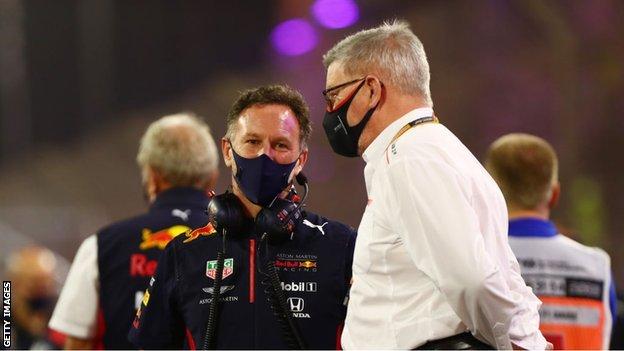ARTICLE AD BOX
 F1 managing director Ross Brawn (right) believes new regulations will lead to a bigger group of competitive teams
F1 managing director Ross Brawn (right) believes new regulations will lead to a bigger group of competitive teamsFormula 1 managing director Ross Brawn says the sport's new technical rules will lead to closer racing and a more competitive field this year.
Brawn says he is "convinced" the cars will be "closer in performance from the very beginning" and "confident these rules will lead to much better racing".
Brawn said: "We may see we don't quite hit a bull's eye in terms of following [directly behind another car] but we will still be so massively ahead of where we were because the old cars were dreadful [for racing]."
What are the new rules?
The new technical regulations amount to the biggest change to the cars in F1 for 40 years. They redefine how a car works in an attempt to solve the problems faced by drivers in recent years when it came to overtaking.
An F1 car's speed is largely defined by aerodynamics. In the past, turbulent air behind cars disrupted the car behind and led to it losing close to half its total downforce when following closely.
F1's calculations suggest that with the new rules this year, a car following directly behind another will retain 85% of its total downforce when one metre behind, rather than 57% in previous years.
On top of that, the restrictive nature of the rules - worked on collaboratively by F1 and governing body the FIA - means the cars should be closer together in terms of performance, with less opportunity for teams to find big advantages.
Brawn said: "Every decision we have made has been towards not dumbing down the sport but making it more achievable to more of the teams and to get a closer competition going on while still leaving it a meritocracy."
Will is shake up the field?
Brawn said he did not expect the rules to change the order too much - unlike in 2009, when a previous rule change saw McLaren and Ferrari, who had fought out the championship the year before, drop down the order and Brawn's own team win.
"I honestly don't think the regs will change the general order of things dramatically," Brawn said.
"I think it will bring it a lot closer and I think we will see some of what were the midfield teams challenging. We'll have a bigger group of competitive teams.
"[Last year] we either expected a Mercedes or Red Bull to win unless something different happened.
"We're blessed with a number of great drivers - [McLaren's] Lando Norris, the Ferrari drivers [Charles Leclerc and Carlos Sainz], George Russell in the Mercedes. Any number of combination of drivers could give us a great season.
"Although there was a bit of a battle between McLaren and Ferrari [last year], if I'd been them very early in the year, I would have been putting everything I could into into 2022.
"I think that's what happened in 2009. If you recall, you know, 2008 - big battle between two of the big teams and they rather fell flat on their faces when they got 2009, but I don't think it will be that severe. I'm not predicting that."
How will the cars change?
The new rules take the focus of downforce generation away from the front wing and ensure that a far greater proportion of total downforce is created by the underfloor.
Rather than the flat floors that have been used in F1 since 1983, F1 is returning to shaped underbodies with so-called venturi tunnels to create downforce using a phenomenon known as ground effect.
This means that the cars will run flatter front to rear compared with previous cars, which used rake - a nose-down stance - to create downforce.
"The cars looked a bit silly - these high-rake cars perched on their nose and waggling their arses in the air," Brawn said.
"They've never really looked like a racing car should look. These ones will look a bit better out on track."
The new cars will also be stiffer, to maintain a stable aerodynamic platform.
The previous era of ground-effect cars from 1978 to 1982 became notorious in the final two years of that era for their rock-hard suspensions, which gave the drivers an uncomfortable time in the cockpits.
This year, drivers who have tried out their new cars in the simulator say they have already noticed a decline in ride quality and a greater sensitivity to bumps.
But Nikolas Tombazis, the head of chassis for the FIA, said: "We think the ride quality and characteristics that make it more easily drivable are not necessarily things that need to be maintained.
"We want drivers to make a difference and we want cars to be difficult to drive not easy.
"It's never easy but certain aspects that make the cars more aggressive to drive are quite important. Yes, engineers have determined it is advantageous to run lower. We will be monitoring that situation but we don't think it is a cause of serious concern."
What about circumventing the rules?
The power of the floor, and the importance of preventing the airflow under the car being disturbed, means it will be advantageous to run the cars as close to the ground as possible.
Some engineers have said this could lead to teams trying to make their floors flex so they 'seal' better to the ground.
Flexible bodywork is an area that often causes controversy - Mercedes and Red Bull had a row last year about flexible rear wings, each accusing the other of cheating.
Tombazis said: "We will always be keeping an eye on any flexibility and we will be imposing tests where necessary to reduce such effects.
"With a new regulation, it is inevitable there will be some areas which were not properly predicted in terms of flexibility that will need to be enhanced as we go along and we will not hesitate to intervene if we find abuse is taking place in certain areas."
Brawn added: "There are bound to be disputes, it wouldn't be F1 without them. It would be naive to think we are not going to have arguments."

- What happened to Shergar? A prize-winning super horse is kidnapped from an enigmatic owner
- Is this a new alternative to dating apps? Find out the unusual way one man is going about finding his perfect other half


 2 years ago
29
2 years ago
29








 English (US)
English (US)